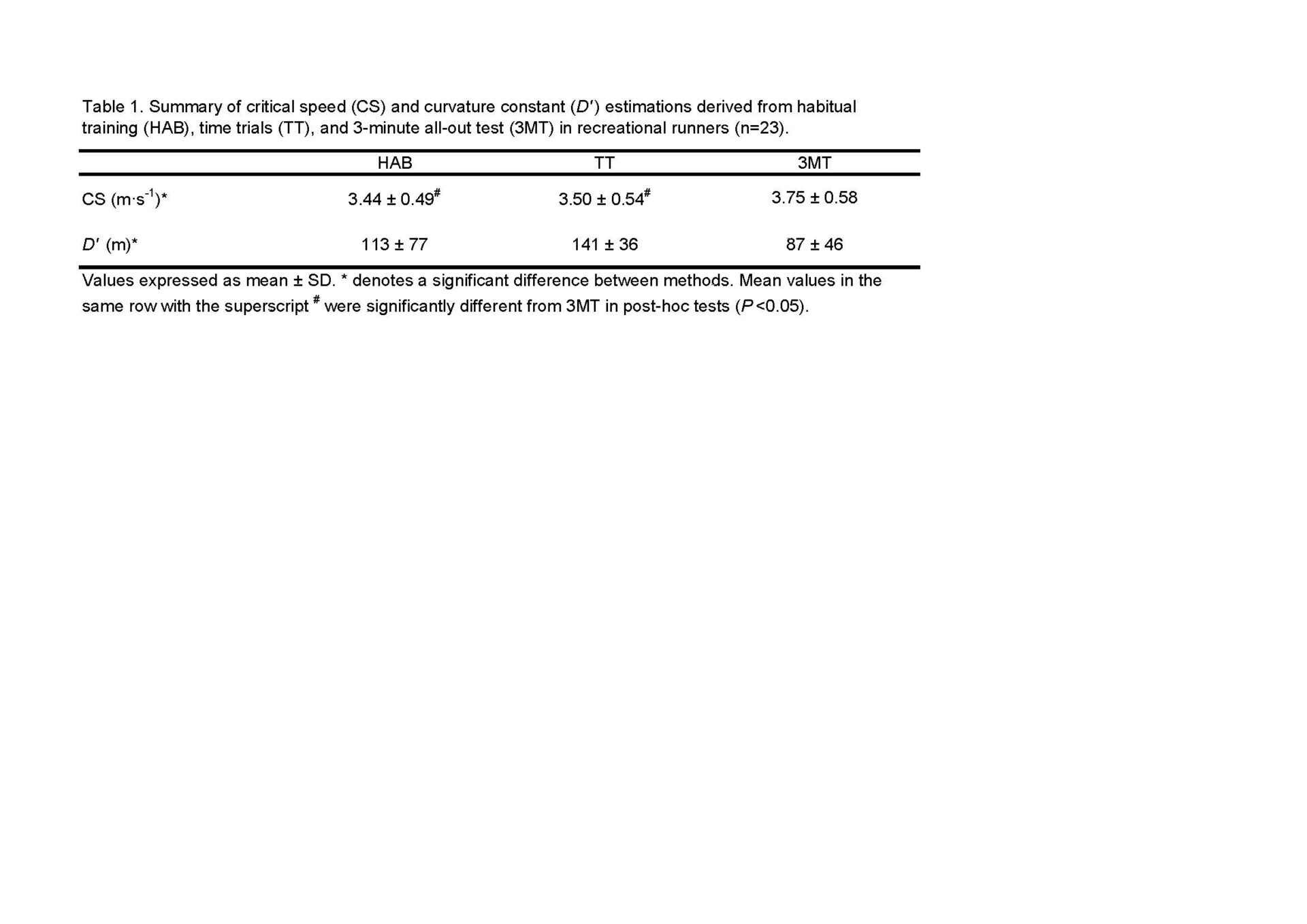Introduction
The relationship between the intensity of exercise (e.g. running speed) and time until task-failure is characterised by a hyperbolic function. The asymptote of the hyperbola, critical speed (CS), represents the highest intensity at which a metabolic steady-state may be achieved, whereas the curvature constant, labelled as D′, represents a finite exercise capacity above CS [1]. CS is therefore an important physiological threshold and, together with D′, offers insight into the limits of human performance [2]. CS and D′ can be calculated from a series of maximal efforts, such as time-trials [TT], constant-intensity tests to task failure, or from a 3-minute all-out test (3MT) [3]. Alternatively, the fastest times recorded over a range of distances during training have been used to estimate CS and D′ [4]. In this study, we aimed to 1) compare estimates of CS and D′ derived from unsupervised field tests (TT and 3MT), and those derived from six weeks of habitual training (HAB); and 2) calculate the test-retest repeatability of the 3MT.
Methods:
Twenty-three recreational runners (females n=4; mean ± SD age 45±7 years) volunteered to participate in this study, and agreed to have their training monitored through a foot-pod (Stryd Inc., Boulder CO, USA) for 8 weeks. Participants followed their habitual training in weeks 1-6. In weeks 7-8, a series of TT (3, 7, and 12 min) and 3MTs were performed in a randomised order. CS and D′ were calculated using the fastest 3, 7, and 12 min recorded at any point in the HAB, from the TT, and in duplicate, from the 3MT. Estimations of CS and D′ derived from TT, 3MT, and HAB were compared using repeated-measures ANOVA.
Results
There was a significant difference between CS estimations across methods (P<0.001, Table 1). Bonferroni post-hoc tests revealed CS3MT was higher than CSHAB and CSTT (P<0.05), but there was no difference between CSHAB and CSTT (P=1.00). Furthermore, CSHAB and CSTT were strongly associated (r=0.86), and the coefficient of variation (CoV) between both estimates was 4.3% [95% CI: 3.1–5.6%]. Similarly, estimations of D′ were different between methods (P0.05) between D′TT, D′HAB, and D′3MT. The repeated 3MTs resulted in estimates of CS which were not different (3.75±0.58 and 3.78±0.58 m·s-1; P=0.276), and had a high agreement (r=0.93, CoV: 3.2% [2.1–4.3%]) with each other. There was no difference between D′ derived from repeated 3MT (87±46 m and 75±46 m; P=0.276), but these values exhibited low agreement (r=0.71; CoV: 25% [13-37%]).
Conclusion
The close agreement between CSHAB and CSTT is promising and of great practical relevance, and warrants future research to investigate the sensitivity of such estimations to assess human performance. However, CSHAB and CSTT were 7-9% lower than CS3MT. Since data collection was performed remotely, and unsupervised, participants may have paced themselves during the 3MT, which may overestimate CS. Therefore, although repeated 3MT resulted in similar estimations of CS and D′, caution is warranted when performing the 3MT in unsupervised conditions.
Biomedical Basis of Elite Performance 2022 (University of Nottingham, UK) (2022) Proc Physiol Soc 49, PC34
Poster Communications: Determination of critical speed from training data: a comparison between field-based tests
Daniel Muniz-Pumares1, Adam Ledger1, Ben Hunter1, Samuel Meyler1
1 University of Hertfordshire
View other abstracts by:
Where applicable, experiments conform with Society ethical requirements.

